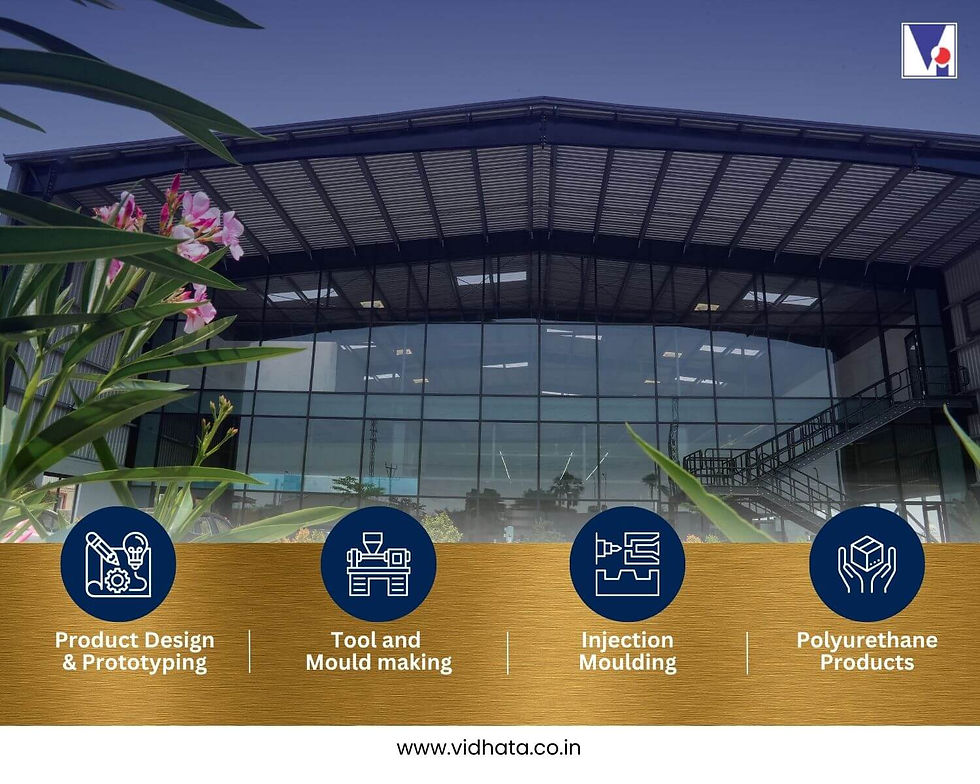Engineering Excellence in High-Cavitation Moulds: Vidhata Plastics’ Precision Approach
- Shraddha Srivastava
- Dec 28, 2024
- 4 min read
Creating high-cavitation moulds isn’t about scaling up production; it’s about achieving flawless replication across dozens, sometimes hundreds, of cavities while maintaining cycle time, durability, and dimensional stability. At Vidhata Plastics, we don’t just manufacture high-cavitation moulds; we engineer precision systems that redefine industry standards.

Here’s a detailed look at the engineering and manufacturing depth it takes to create the best high-cavitation moulds.
How to create the Best High-Cavitation Moulds
1. Achieving Uniform Cavity Performance
Balanced Flow Dynamics
When molten plastic enters multiple cavities, even minute imbalances in flow can cause defects like short shots, flash, or uneven cooling. Perfecting flow dynamics is critical.
How We Solve It:
Runner Design: Our engineering team creates highly optimized, symmetrical hot or cold runners, ensuring identical flow rates and pressure across all cavities. Advanced simulation software identifies and corrects potential flow imbalances during the design phase.
Valve Gate Systems: For applications requiring pinpoint precision, valve gates control material flow into each cavity, eliminating stringing and ensuring pristine part finishes.
Cavity Precision Tuning
No two cavities can vary in dimension or surface finish, even by microns. Variations impact part quality and downstream functionality.
Our Solution:
Mirror Image Tooling: Cavities and cores are machined in tandem using high-speed CNC and wire EDM to achieve identical geometries. Sub-micron alignment ensures zero deviations.
Integrated Tool Wear Compensation: By analyzing wear trends in high-cycle environments, we pre-emptively account for potential deviations in cavity dimensions, extending mould lifespan.
2. Cooling Systems That Define Efficiency
Heat management is the cornerstone of high-cavitation mould design. Uneven cooling can warp parts, distort dimensional accuracy, and increase cycle time.
Our Cooling Mastery:
Conformal Cooling: Unlike conventional straight-line cooling channels, our conformal cooling systems follow the contour of the mould cavity, ensuring consistent temperature control. These are designed using advanced 3D modelling for maximum heat dissipation.
Material-Integrated Cooling: For high-heat applications, we incorporate high-conductivity inserts like beryllium copper in high-stress zones while retaining steel for structural strength.
Thermal Zoning: Multi-zone temperature controllers are integrated into the mould, enabling precise temperature management for different sections, especially in complex mould designs.
3. Precision Ejection Systems
Part ejection is a make-or-break phase in high-cavitation moulds. Even slight misalignments or uneven force can lead to deformities, ejector marks, or part damage.
Our Ejection Expertise:
High-Speed Synchronized Ejection: Multi-point ejector systems with servo-driven actuators ensure uniform ejection force across all cavities, critical for thin-walled or intricate components.
Anti-Warp Ejector Design: We utilize stripper plates or air-assisted ejectors for delicate parts, ensuring they retain their shape and surface integrity during ejection.
Durable Ejector Components: Hardened steel ejector pins with advanced coatings like titanium nitride enhance longevity and maintain consistent ejection performance over millions of cycles.
4. Material Science Integration
Material selection for high-cavitation moulds is more than a choice of steel—it’s a strategic decision affecting thermal conductivity, wear resistance, and structural integrity.
Our Material Choices:
Core and Cavity Inserts: H13 and P20 tool steels with advanced treatments (e.g., vacuum hardening, chrome plating) for long-term wear resistance.
Base Plates: High-tensile steel alloys ensure structural stability under intense clamping forces.
Surface Coatings: DLC (Diamond-Like Carbon) or nitrided coatings on sliding and wear surfaces reduce friction, extend mould life, and improve part finish.
5. Micro-Level Alignment Precision
With a mould containing 96 or more cavities, any misalignment—however small—compounds into significant quality issues. The challenge is to maintain perfect alignment between plates, runners, and cavities across the mould’s lifecycle.
Our Alignment Innovations:
Self-Centering Guide Systems: Precision-ground leader pins and bushings ensure consistent plate alignment, even after millions of cycles.
Dynamic Wear Compensation: Modular inserts allow quick adjustments for cavities that show wear or alignment shifts during high-volume production.
Zero-Tolerance Machining: We employ coordinate measuring machines (CMM) to validate cavity alignment post-manufacture, achieving sub-micron precision.
6. Durability in High-Cycle Production
High-cavitation moulds are subjected to immense wear due to continuous operation under high pressures and temperatures. Ensuring long-term durability without compromising part quality is a defining hallmark of our moulds.
Our Strategies:
High-Pressure Endurance: Reinforced mould bases and hardened components withstand pressures exceeding 1,000 bar, critical in high-speed injection moulding environments.
Dynamic Stress Analysis: Using FEA (Finite Element Analysis), we identify stress hotspots and reinforce mould structures during the design phase.
Optimized Mold Lubrication: We design integrated lubrication channels in sliding mechanisms to minimize wear and ensure smooth operation.
7. Intelligent Maintenance Design
Downtime is costly in high-volume production. Moulds must be easy to maintain without compromising cycle efficiency or alignment.
Maintenance-Ready Features:
Modular Construction: Replaceable cavity inserts and cores enable quick fixes for wear and tear without disassembling the entire mould.
Wear Monitoring: Integrated sensors monitor wear in real time, allowing predictive maintenance and reducing unscheduled downtime.
Quick-Release Mechanisms: Standardized fasteners and guided dismantling reduce maintenance time, keeping operations running efficiently.
Applications of Our High-Cavitation Expertise
Medical Devices: Bloodline connectors, drip chambers, and injection syringes, requiring impeccable accuracy and surface finishes.
Packaging Components: Thin-walled caps and closures, engineered for minimal material usage and high-speed ejection.
Consumer Goods: High-volume parts for personal care, household, and electronic components.

Why Vidhata Plastics Is the Leader in High-Cavitation Moulds
Precision Unmatched: Sub-micron accuracy in cavity design and alignment.
Durability Assured: Moulds designed for millions of cycles with minimal wear.
Innovative Cooling and Ejection: Advanced systems for reduced cycle times and consistent quality.
Tailored Solutions: Every mould is engineered to client specifications, optimized for their production environment.
At Vidhata Plastics, creating high-cavitation moulds is not just manufacturing—it’s an engineering art form. Our commitment to precision, durability, and innovation ensures that your production lines achieve maximum efficiency and reliability.
Contact us today to discuss how our high-cavitation mould solutions can elevate your manufacturing capabilities.
Visit Our Website: https://www.vidhata.co.in/
Contact Us: https://www.vidhata.co.in/contact
Email Id: info@vidhata.co.in
WhatsApp No. : +919550665666



Comments